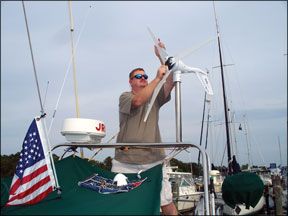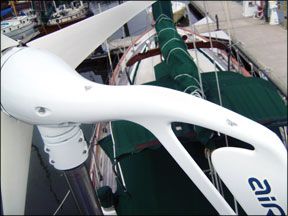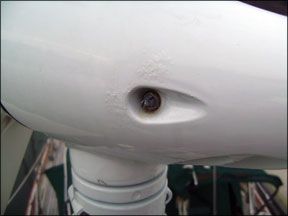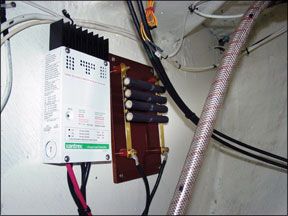During our wind generator test in March 2007, Southwest Windpower (maker of the Air X wind generator) provided us with a prototype of a new unit the company was working on, the Air Breeze. After testing the prototype, Practical Sailor felt it had a lot going for it, but since it was not a production model, we did not rate it.
Southwest Windpower debuted the Air Breeze wind generator in spring 2008. Practical Sailor received one of the new units for installation and evaluation aboard one of our test boats, a Union 36 based in Chesapeake Bay, Va. According to the maker, the new Air Breeze boasts a number of design improvements over the Air X unit, resulting in lower wind-speed startup, greater output, and quieter operation.

How we tested
Practical Sailor testers have observed the Air Breeze unit under a wide variety of conditions for the last several months. The monitoring system aboard our test vessel is the same used during our 2007 wind-generator test: a Xantrex XBM Battery Monitor and Xantrex C40 Charge Controller (www.xantrex.com), and a resistive or “diversion” load purchased from Hotwire Enterprises (www.hotwire.com), maker of the popular KISS wind generator. Output power (in amp hours) was measured and logged by the Xantrex Battery Monitor, which is installed so that the true output of the units is recorded independent of vessel battery bank state of charge.
The new Air Breeze
Offered through retail giant West Marine, the Air Breeze is available in 12-, 24-, or 48-volt DC models and has a rated power of 200 watts at 28 mph. It uses a three-phase, brushless permanent magnet alternator, which produces AC power that is internally rectified to DC. Turbine control is via a new microprocessor-based smart internal regulator utilizing peak power tracking.
This new controller features improved power tracking (maximizing energy production at all wind speeds), more robust Field Effect Transistors (FET), and electronic stall control, which reduces shutdowns in high winds.
The Air Breeze also has an internal voltage regulator with a factory set point of 14.1 volts (for 12-volt systems). This set point is also field adjustable to suit different charging regimes (an AGM battery, for example). The microprocessor-controlled circuit and alternator allow the turbine to self-regulate in high winds and to automatically stop when the batteries are charged. Normal charging resumes when the battery voltage drops slightly below the fully charged level.
The new Air Breeze also has a charge LED display located on the bottom of the unit, a neat feature that gives a visual indication of unit output and also can be used as a troubleshooting aid.
Construction
Our testers found overall construction of the new Air Breeze to be good. With only two moving parts, maintenance for the unit should be minimal. The body is powder-

coated cast aluminum and (like the Air X) has a distinct, downward pointing tail fin with a small cut out that the maker says allows for better wind tracking and stability in rough seas. During our 2007 test, we noted that the prototype unit tended to “seek,” or spin on its mount at times. However, this hasn’t been observed with the production model.
The Air Breeze unit boasts totally redesigned blades constructed of glass-filled polypropylene (versus the carbon-fiber composite blades of the Air X model). The new blade design has 30-percent more area and features a boundary layer disrupter for quieter operation. The manufacturer claims this wider airfoil provides lower startup, improved overall performance, and greater durability.
The Air Breeze also features improvements in hub design and blade assembly. The blades quickly and easily lock into the hub with just one fastener per blade. The hub itself has been redesigned for increased strength and safety.
One feature our testers particularly liked about the Air Breeze was its ease of mounting. (The prototype was by far the easiest unit to mount in our 2007 test.) The base simply slides on and clamps to a 1-inch diameter, schedule-40 pipe, providing 360 degrees of continuous operation.
Testers did note coating failures on both the wind generators aluminum body and, to a more significant degree, on the blades. The blade coating failure did not seem to affect performance significantly, but the exposed blade surface was rough and showed some exposed fibers, suggesting a loss of efficiency.
Although no deep pitting was yet present on the aluminum body, the loss of coating would make it more prone to corrosion. This wear and tear occurred in just six months of use. Southwest Windpower said it has enhanced the UV inhibitors in the blade coating and switched to a darker color, further improving its UV resistance. It is investigating the causes of coating failure.
Operation
Start-up wind speed for the Air Breeze is advertised as 6 mph, 2 mph less than the Air X. Maximum or “survival speed” is listed as 110 mph, with over-speed protection provided automatically by electronic torque control and manually by a stop switch that is included in the package.

The Air Breeze also uses stall control of the blades. According to the makers, this function is much quieter than it was in previous models (such as the Air X 403) since the stall mode is activated by the controller before the flutter RPM is reached. The result is a dramatic reduction in RPM in wind speeds above 35 mph, reduced wear on blades and bearings in high winds, and-most importantly-protection of the turbine from damage due to high winds.
Stall mode is activated at about 35 mph and stays in effect until wind speed drops below 32 mph. If the Air Breeze senses wind speeds above 50 mph, it will shut down completely for five minutes.
Observations
The 6-mph start-up wind speed advertised for the Air Breeze matched our observations. However, don’t expect any significant power production until wind speeds reach the 12- to 14-mph range or greater.
Testers had the chance to observe the Air Breeze for approximately six months. During a breezy 24-hour test period with average wind speeds ranging from 8 to 14 mph with occasional higher gusts, output ranged from 79 amp hours (Ah) to almost 87 Ah, an average of approximately 3.4 Ah per hour. We also recorded 122 Ah for one 32-hour period for an hourly average of 3.8 Ah. The table above shows output. This average exceeds all those in our 2007 tests, but because of wind-speed variations, any direct comparison between this test and the one in 2007 would be unreliable.

Although any attempt to nail down unit output will vary greatly according to location, based on our observations, you should be able to bank 85 Ah during a typical day on the Chesapeake. Again, this is just an average based on our 24-hour test periods-actual output can be significantly higher or lower.
As with the prototype unit during our 2007 test, the production model of the Air Breeze was quiet. Noise levels were barely perceptible above background noise at most wind speeds.
A set of three spare blades is available at West Marine for $100, but apart from that, the Air Breeze has limited field repair options.
Bottom Line
The Air Breeze unit is well built, quiet, and easy to mount. At $900, it is reasonably priced. Its performance and ease of installation help earn it a spot as a Practical Sailor Recommended product.
The new darker blades with UV inhibitors should help boost resistance to sun damage. We recommend using Tef-Gel (www.tef-gel.com) or a similar product to isolate any stainless fasteners from the aluminum body and hub. A wax or protectant with UV inhibitors may also help protect the blades and body finish.
In terms of output, the Air Breeze seems consistent with the prototoype we tested in 2007. Based on that test, our Best Choice wind generator is still the heavier-duty Superwind 350. Data recorded during that head-to-head test accompany the online version of this article at
www.practical-sailor.com.



































